Landscaping and Designing a Home Garden
More and more people are retreating to the serenity of their gardens. They want to get respite from their busy lives and fill the days and weeks of leisure they have deservedly earned.
Now, it may be the process of gardening that attracts you or the appeal of the finished landscape. There is no doubt that many gardeners view their outside garden as an extension of their indoor living spaces.
If you’re interested in designing your own garden homes, keep reading to learn the right way to do it. This will help you plan your garden more systematically.
More and more people are retreating to the serenity of their gardens. They want to get respite from their busy lives and fill the days and weeks of leisure they have deservedly earned.
Now, it may be the process of gardening that attracts you or the appeal of the finished landscape. There is no doubt that many gardeners view their outside garden as an extension of their indoor living spaces.
If you’re interested in designing your own garden homes, keep reading to learn the right way to do it. This will help you plan your garden more systematically.
Different ways to design a home garden
It may seem that creating a well-designed home garden needs a lot of creativity or space. But that is not the case; you can have your personalized home garden as per your liking without putting much effort.
The best way to do that is to understand the garden design concept and implement it as per your needs.
Garden Rooms: Sun-splashed brightness
Designing your garden as a series of rooms has many benefits. This is in addition to privacy, cohesive design, an illusion of space, and variety in both form and function.
You can create garden rooms that are ideal for isolating color schemes or garden styles that may fit your home’s overall look.
You can have a perennial bed of different colored flowers where you can spend time looking around. However, you need to consider your outdoor living space requirements when creating a garden room.
Here are some considerations when designing garden rooms:
- Have a covered space for outdoor dining and easy access to the kitchen for entertaining and casual family meals.
- Create a spacious long hedged plant for a safe and secure play area for kids
- Develop a pond or small water feature for a relaxing space where you can place a small gazebo or shaded bench to have a quiet time
The garden design rooms can be entirely or partially enclosed, separated, or linked and flowing naturally into each other.
The great thing with garden room design is that it should not be large, structured, or expensive to create. You may already have space available to further enhance it by a strategically placed screen or path there.
If you have more space, you can divide it into several rooms, creating several gardens within a garden, each with its distinctive mood or purpose.
In the end, it doesn’t matter a lot whether your garden is on acreage, an urban lot, or at a small space patio. You can have a beautiful garden by designing it as a place where you can live in, as well as admire from afar.
Garden Floors for elegant design
A thoughtful design of garden floors is vital for a beautiful looking garden. Garden floor design creates ambiance in the garden as a whole. No one likes to look at the haphazard or tasteless garden path.
The key to a successful garden floor is to use a mix of both hard and soft materials. Some of the hard features include stone, brick, and wood. Delicate features contain plants in all their shapes, colors, and textures.
Design a breathtaking flower bed
Many options are available to gardeners who seek a change from the usual rectangular, curved, or island flower beds. Some alternatives include both very traditional and formal garden designs.
Here are some trendy flower bed designs that you can impart in your backyard or front, depending on space.
Create a Knot garden for style
Knot gardens were popular garden design types in earlier England and France. It had elaborated and symmetrical knots traced out with low-growing, evergreen herbal hedges, planted to weave together sophisticated patterns and usually set in a square framework.
Herbs of different foliage colors can be selected for each knot band to create contrast and highlight patterns’ woven nature. You can use flowers such as lavender, thyme, rosemary, and popular hedge materials to prepare a knot garden.
The clipped hedges make the landscape look beautiful. You can fill the know with various herbs, flowering plants, or inert colored materials such as sand or pebbles.
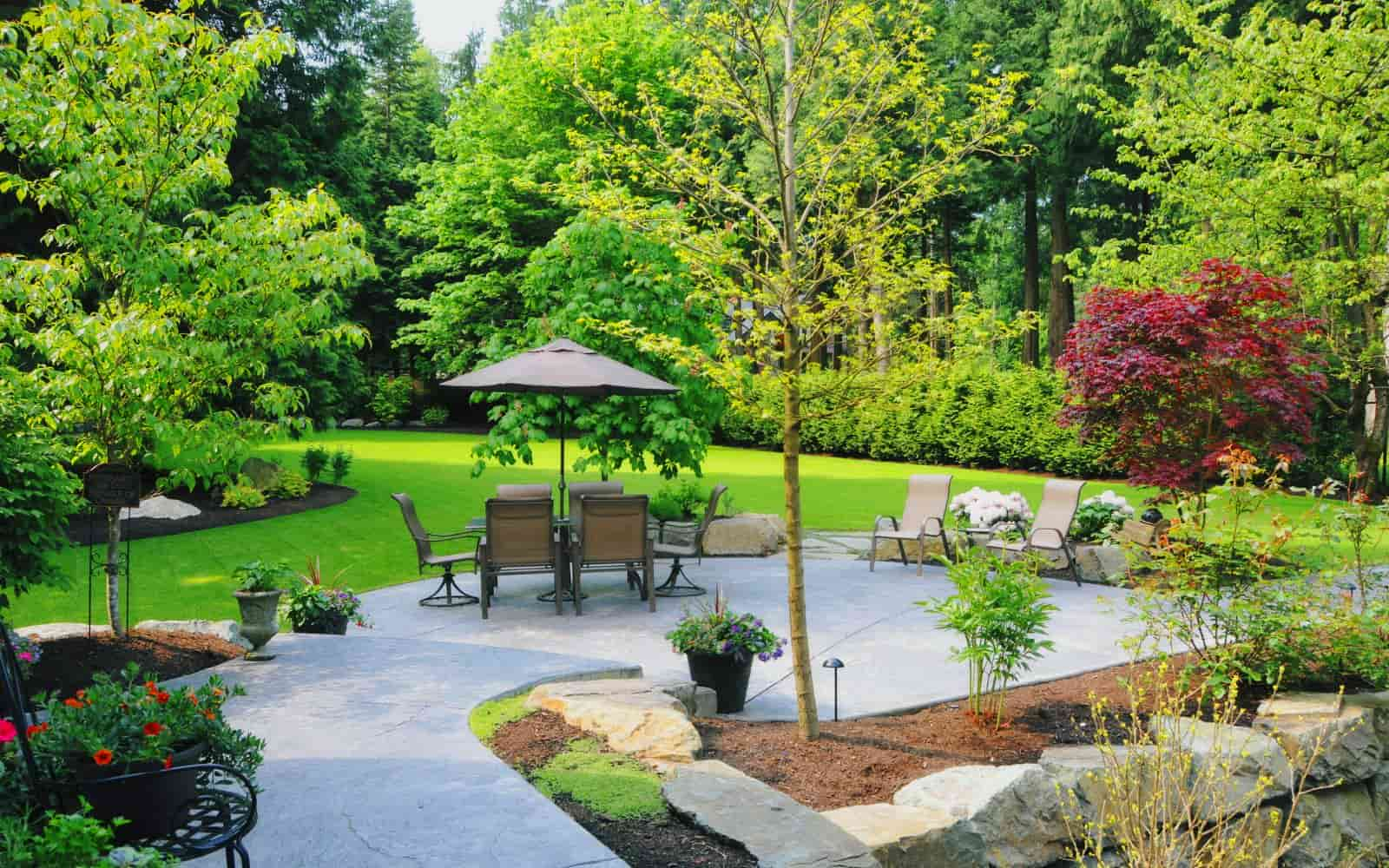
Classic English Style Cottage Garden
Many people know the origin of the cottage garden as English. It has a long, rich history and favorite among many gardeners. A cottage garden design layout consists of a wide variety of flowers, herbs, and sometimes even vegetables.
The cottage garden plants were sheltered by stone walls or picket fences, crisscrossed with beautiful pathways, and wooden benches for rest.
When you start with a cottage garden, start with a sunny yard and surround it with clematis-class fences. You can then add a mixture of traditional flowers such as delphiniums, peonies, daisies, phlox, and hollyhocks.
To add some variety, you can also plant vegetables and herbs alongside. You can keep woody ornamental flowers to a minimum to let the sunshine in.
Suppose you live in a relatively colder climate. In that case, you can choose plant varieties that grow naturally small, columnar, or have a growing cycle that minimizes the shade in the garden.
For a warm climate cottage garden, choose plants that grow long and provide shade from the sun’s scorching heat. Allowing spacious pathways around the garden gives you access to flowers and shrubs for easy maintenance.
You can add a finishing touch by adding a slightly curved path leading to a sundial, stone, or wooden bench to gaze at the beauty of your garden.
Create a Sturdy and Long-Lasting Rock garden
If you live in a harsh weather condition where temperatures fall below several degrees, having a rock garden will be the right choice.

The use of Alpine plants in the rock garden is suited in dry summer and cold night temperatures. You have to ensure that the plants are protected from winter winds and sun.
Raised flower beds in the rock garden are attractive and easy to maintain. When designing a rock garden, you can incorporate a one-third garden area with screened and washed rock grits. Another one-third with playbox sand, and the rest with peat moss or compost.
You can also visit local garden centers for new ideas. There you learn about the endless variety of striking plants and rock garden designs available for beginner and experienced gardeners.
Make a Good Use of Groundcovers
A dense mat of groundcovers is an excellent gardening floor alternative to traditional lawns and flower beds. You have to be a bit careful when deciding on groundcovers as some may not be suitable for heavy foot traffic.
There are two types of groundcover you can use in your garden. The first type colonizes naturally, spreading by underground rhizomes.
Groundcover plants included in this category are creeping Jenny, periwinkle, ajuga, and goutweed. These plants are useful groundcover but also need proper care from time to time.
The second type forms clumps that are equally effective at filling in empty spaces but are more orderly and predictable. This makes it easier groundcover to maintain.
Keep in mind that when you are planting groundcover plants, these should be relatively maintenance-free and be efficient at keeping weeds out and moisture inside.
Some of the popular groundcover plants known for ease of maintenance and visually appealing are Bergenia, ornamental grasses, daylilies, hostas, and thrift. These are clump-forming plants that provide the uniform groundcover.
You can use Herbaceous groundcovers anywhere and everywhere. These are incredibly beautiful in combination with spring-flowering bulbs. These are also excellent for filling in tricky spaces where the grass is difficult to grow or maintain.
How to contain invasive plants
Plants that spread rapidly through underground rhizomes are useful as groundcovers, resulting in almost instant coverage of bare ground.
You can use these in the suburban landscape, but care must be taken to contain them. This is truer when groundcovers have the potential for invading neighbor’s gardens as well as overrunning your own.
Here are some tips to contain invasive plants.
- Plant wisely by taking advantage of pre-existing barriers such as controlling invasive between a driveway or sidewalks, including home foundations.
- In flower beds, submerge invasive plants in large pots. As long as the pots have adequate drainage, you don’t need to remove the bottoms. Make sure the rims stand 5 cm above the soil level.
- On the property line, make sure to install a barrier that reaches a depth of at least 45 cm to prevent roots from taking hold of the neighbors where they might not be welcome.
Techniques for home garden design
There are different techniques that you can incorporate when it comes to garden design. These techniques consist of separation of color and texture of plants.
Partitions
Partitions are a great way to decorate your garden. Partition walls, fences, and hedges serve both practical and aesthetic purposes in the garden as it demarcates transitions between different parts of the garden.
Use the following strategies to partition your garden.
Walls
You can use low stone or brick walls to create a partition that helps to shelter plants from the year-round damaging effects of the winds.
Walls also help mitigate the effects of cool evenings by providing suntraps for heat-loving flowers, herbs, and vegetables.
Walls also add privacy and security from other wild animals getting inside your garden and ransack delicate flower beds or destroy edible gardens.
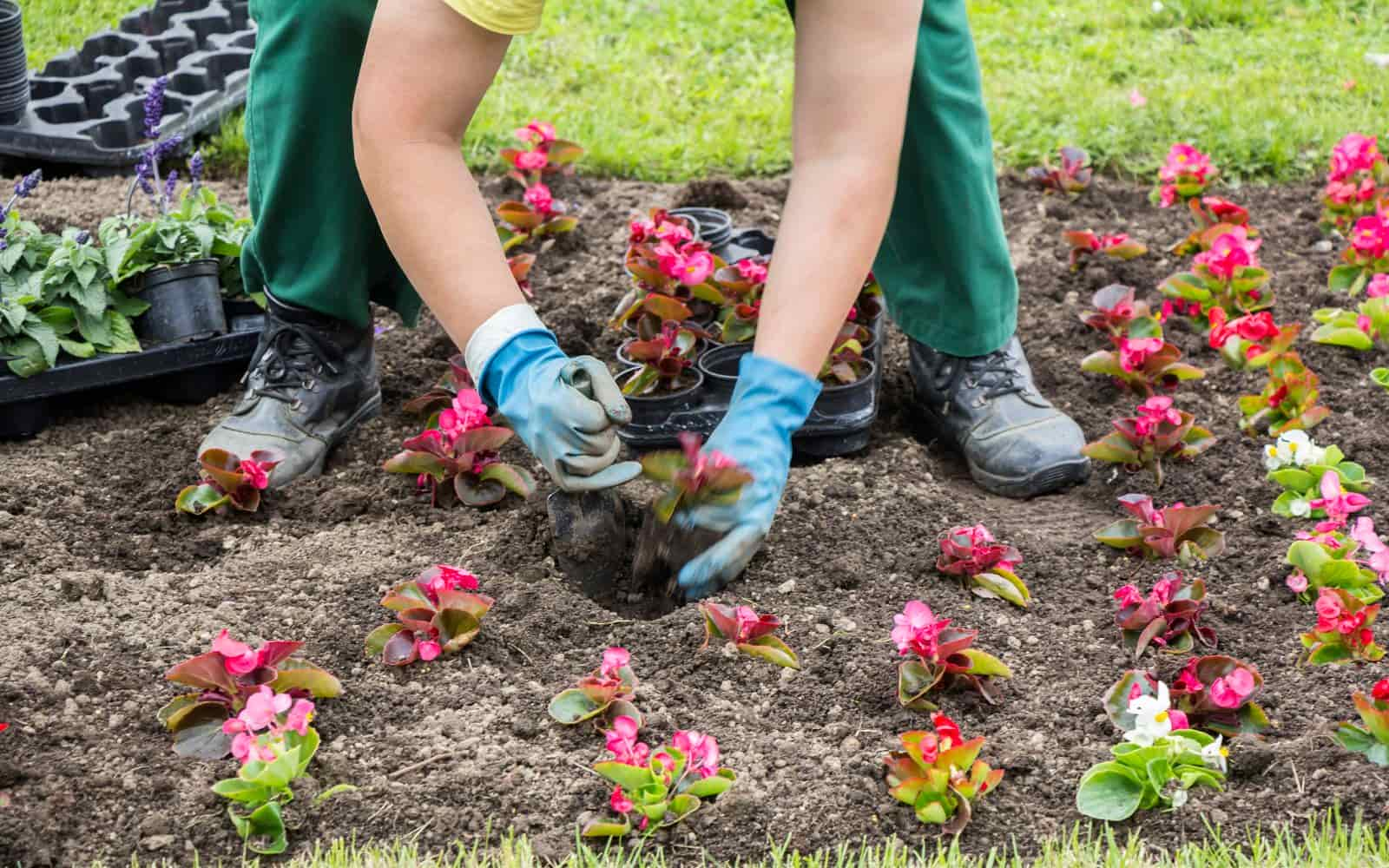
Fences
The use of a low fence within a garden area allows privacy without obstructing views. You can have a rustic look at the garden using short crossed poles or a scaled-down fence.
You don’t have to settle for boring and bland looking fence either as you can paint them with your favorite colors and create the look of English country garden style.
Inside your garden, the internal fences don’t need to be as sturdy as those at the perimeter. But there should be a sense of unity in the materials chosen for all visible fencing.
You can also make your garden appear large if boundary fencing is screened by plantings or painted with some obstructive color.
If you want to enjoy the sense of enclosure, you can paint it white to set off the flowers’ colors against it.
Hedges
Many beginner and experienced gardeners prefer green, living enclosures to wood, bricks, or stone.
While it requires a certain amount of maintenance, deciduous or evergreen hedges are attractive screens to either divide areas of your property or hide or replace an unsightly fence.
When you are planting an evergreen hedge, it requires pruning only once a year. But these hedges can eventually occupy a great deal of space that is best for large properties. Several deciduous hedges can be chosen to provide bark or foliage colors, blossoms, or fruit.
When you’re growing flowering hedges, it may be selectively pruned by hand. You can use plants such as bush honeysuckle, spirea, potentilla, and hardy roses. These make an excellent hedge with a profusion of blooms.
For tall screening hedges, you can use Siberian elm, lilac, and Amur maple hedges.
Pathways
Well-thought pathways are among the most critical design features in a landscape. You need to take as much care in the planning and installing pathways as you would in designing other landscape features.
Pathways provide practical means for coming and going through your garden and keep visitors’ feet clean and dry. These days you have several options to construct a straight, formal path or a curved informal path. It all depends on your home layout and your taste.
Regardless of your property size, different pathways work as long as you choose a design that complements the building’s appearance and spirit.
Here are some of the design of the pathways that you can explore in your garden.
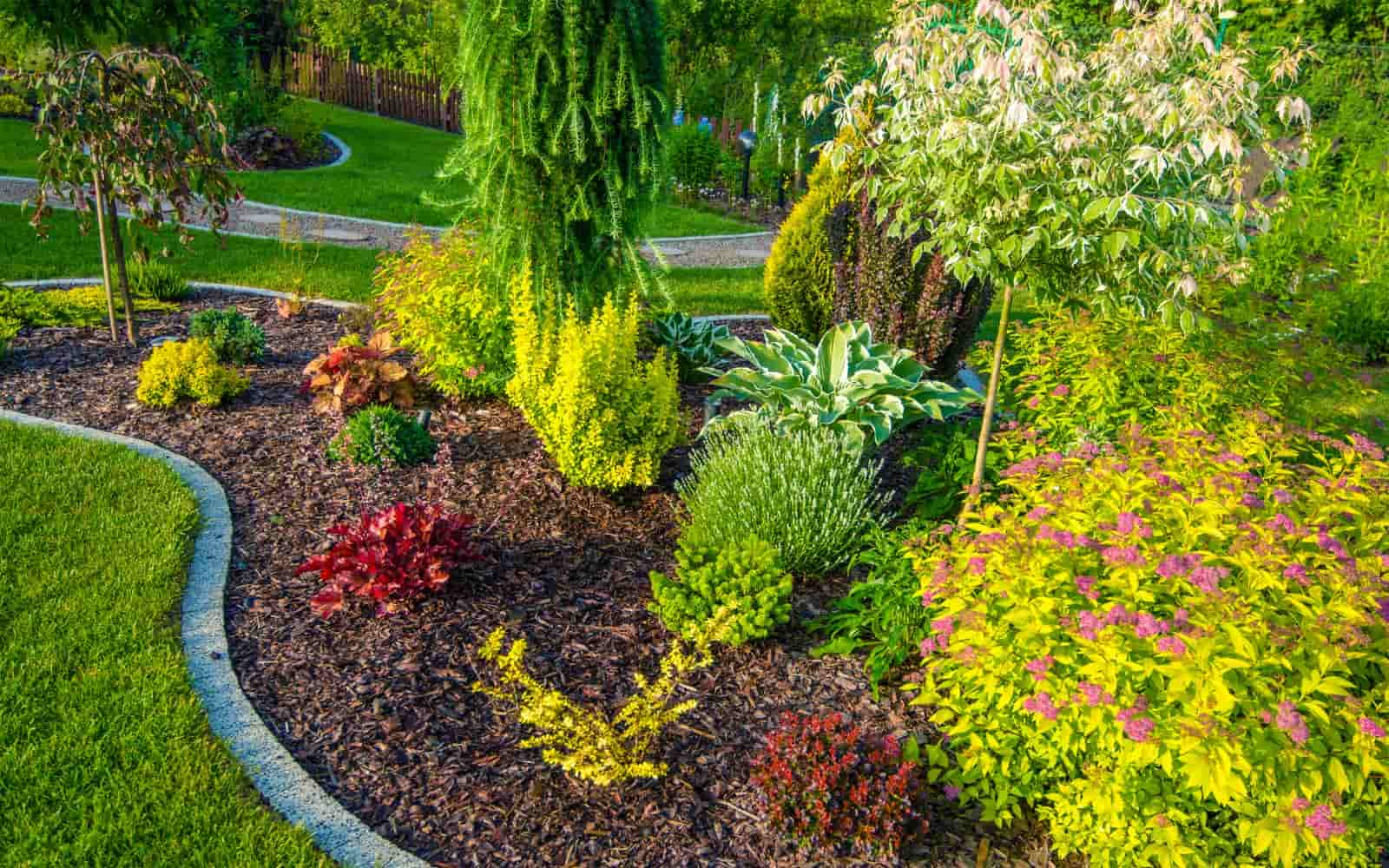
Formal path
A formal path is a straight path design. You can use this design choice to define and separate symmetric flower beds with beautiful geometric shapes. You can lead the visuals to focal points such as a statue, fountain, garden bench, or decorative urn.
The straight design path all helps to create a visual illusion. For example, a track that narrows slightly along its length creates an impression of a wide and deeper garden than it is.
The straight formal paths are direct and unobstructed. This makes the visitors not inclined to linger over individual plants or features but admires the garden’s overall look.
You can use hard, straight edge paving materials for the construction of formal paths. If your house is made of brick, you can create uniform landscaping by building a complementary brick path.
The use of contrasting paving material can help break up the monotony of a large expanse of pavement. However, use it conservatively as overuse can make the final result look busy.
Informal path
Informal paths are suitable for homes that have less formal architectural styles. These are gently curved pathways and need more skill to design but are more adaptable.
The informal curved paths mimic the harmony with a garden design flow of irregularly shaped flower beds or hedges. It encourages you to explore the whole garden at a relaxed pace and pause and enjoy the well-crafted garden’s details.
When you are designing an informal path, it needs a reason for curving. It must go around something substantial such as a collection of shrubs, tall perennials, or large trees.
To make the curved path more apparent and appealing, it must proceed in broad sweeps, not in short wobbles. There is nothing beautiful or relaxing for paths that wiggle unstructured across the landscape.
Note:
Whatever pathway style you choose, ensure that a pathway leading to your home entrance should be prominent. It should be at least 1.5 m wide. It’s the minimum width that will allow two people to approach walking side by side.
Secondary pathways that are not widely used should be a minimum of 0.75 m wide, a comfortable width for walking single file.
Also, make sure that every path has a purpose or a destination and avoid dead ends. You can make pathway loops to let visitors move in a fluid motion.
Structures
Structures are an essential part of the landscape, and in earlier days, ornamental architecture was the height of gardening fashion.
Structures are not just there to make your garden look good, but there are several benefits to including it in your garden.
A well-designed structure provides a vertical space upon which plants may grow. It can be an attractive focal point or destination at the end of the paths.
It can also help establish microclimates and shield trees, shrubs, and perennials from the devastating effects of winter chinook winds or summer hailstorms.
You should consider the type of structure and the material to use to complement garden design and plants. You may also need to consult local by-law regarding building permits or height restrictions when building structures.
Here are some structures that you may consider building in your garden.

Gazebos
Gazebos, also known as the summerhouse, is located from where most of the garden is visible. Well-located gazebos provide a place to escape from a hot midday reprieve in the summer. You can ornate it with other floral arrangements to give it a serene look.
Gazebos are ideally suited for extensive gardens. But you can have smaller gazebos to fit into smaller gardens and include space enough for only a few chairs and a table.
There are many choices of materials and designs for your gazebo. You can choose from a traditional white wooden gazebo complete with lattice-work to a wrought-iron structure reminiscent of the Victorian time.
Pergolas
Pergolas are structures consisting of uprights joined with horizontal beams and cross-beams to form walkways. You can use it to link different areas of the garden.
These are also suitable for climbing vines up and over the framework, providing light shade and privacy. Pergolas are generally squared off in shape, tunnels, and walkways.
These days you can also construct it in a series of linked, vine-draped arches. For a small garden space, you can hang a chain or rope between upright positions.
Arbours
Arbours are small and simple structures made of a framework over which plants are trained to form a shaded green bower.
You can place it in a shaded corner against a backdrop of trees or shrubs by intertwining or weaving willow branches together and planting shade-tolerant vines to enclose the structure.
Arches
You can use arches at the garden’s entrance to combine decorative gates and pathways to define individual garden rooms.
These are particularly effective when used to frame a view such a raised garden beds or container gardens. The most significant advantage of arches is that these are lightweight but sturdy enough to support climbing plants.
Trellis
Trellis is the most straightforward kind of structure that you can have in your garden. These are made from different material types and styles.
Wooden trellis is the most common. It’s used as a screen or against a wall to support annual or perennial vines.
You can build it on your own or purchase it as per the available space. The traditional patterns for the trellis to support plants are often simple diamond or square designs.
You want to pay careful attention that the trellis does not get obscured by flowers and foliage climbing on it.
Here are tips on designing and using trellis:
- Ensure trellising systems are in place before you plant or as soon as climbers begin to grow in the spring
- Choose trellising material to suit the weight of the plants to be supported.
- Remove tender climbing roses from trellises for the winter
- Prevent cucumber and squash from rotting by tying them onto horizontal or vertical trellises
- Plant a small-flowered clematis under a tree and help it clamber up into the branches
- Train self-climbing perennial vines such as Engelmann ivy on trellises instead of allowing them to climb up house walls
Garden plants for colors
Most people wish to have a visually appealing garden. Experienced gardeners know that a well-composed garden should be full of wide color range and texture to make it look tranquil and pleasing.
Planting flowers for color is an excellent way to accommodate your desired plants in a pleasing garden design. When you are planning your garden, take into account the background colors already present in your landscape.
Color is affected by the intensity of light, which changes with the seasons. Certain colors also seem to be more suitable for particular seasons.
For example, yellow is a refreshing color in spring. Summer is a season of bold contrasts and deep green foliage. Fall is the time to match the mood of nature with different hardy plants.
Blue Gardens

Blue gardens can evoke the intensity of clear sky and almost purple hues of distant mountains. It also creates an illusion of space ideal for a small garden.
Flowers like lilac and lavender are a great addition to blue gardens. When designing your blue garden, you should separate the clear, intense blues from the softer shades.
You can accomplish this by using foliage in shades of grey or silver with flattering blue flowers.
Red Gardens
Red gardens are hot and vibrant with the color of excitements. The red color flower needs space, and too much red can be overpowering in a small garden. However, if you have space, a sunny corner with a red color flower will glow.
There are some pure, saturated red flowers, such as the ‘Champlain’ explorer series rose.
You can always mix red with other colors. Pink and plum are also in the red family and are more adaptable to small urban gardens.
Pink Gardens
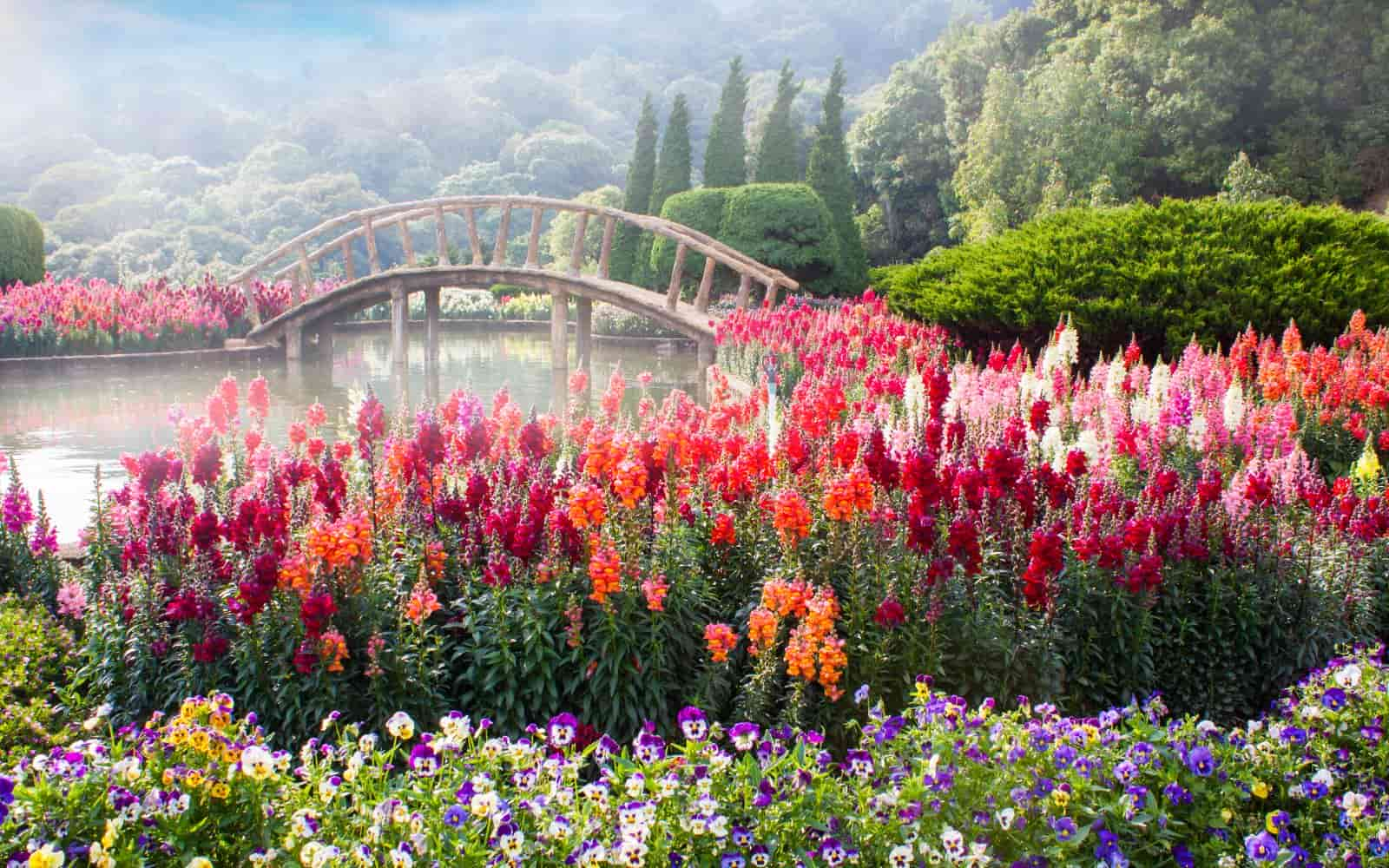
Pink gardens can be soft, romantic, and tropical. There are so many different varieties of flowers that perfectly fit the pink garden theme.
When you’re developing a pink garden, try not to use too many pastel pinks together. You should incorporate several shades of light to dark pink, separating cool and warm pinks.
Yellow gardens
Yellow is a bright, eye-catching, and cheerful color like sunshine. However, similar to red, yellow alone can be too much for a small garden.
You can use yellow to brighten otherwise dark areas. If you wish to plant a yellow garden, use plenty of pale yellows, as well as saturated bright yellows.
You should also consider using a generous amount of white or cream to soften the effect. Consider creating a sunrise or sunset garden for a stronger yellow saturated garden. You can combine it with red and orange to pick up the warm glow of the sun’s ray.
White gardens
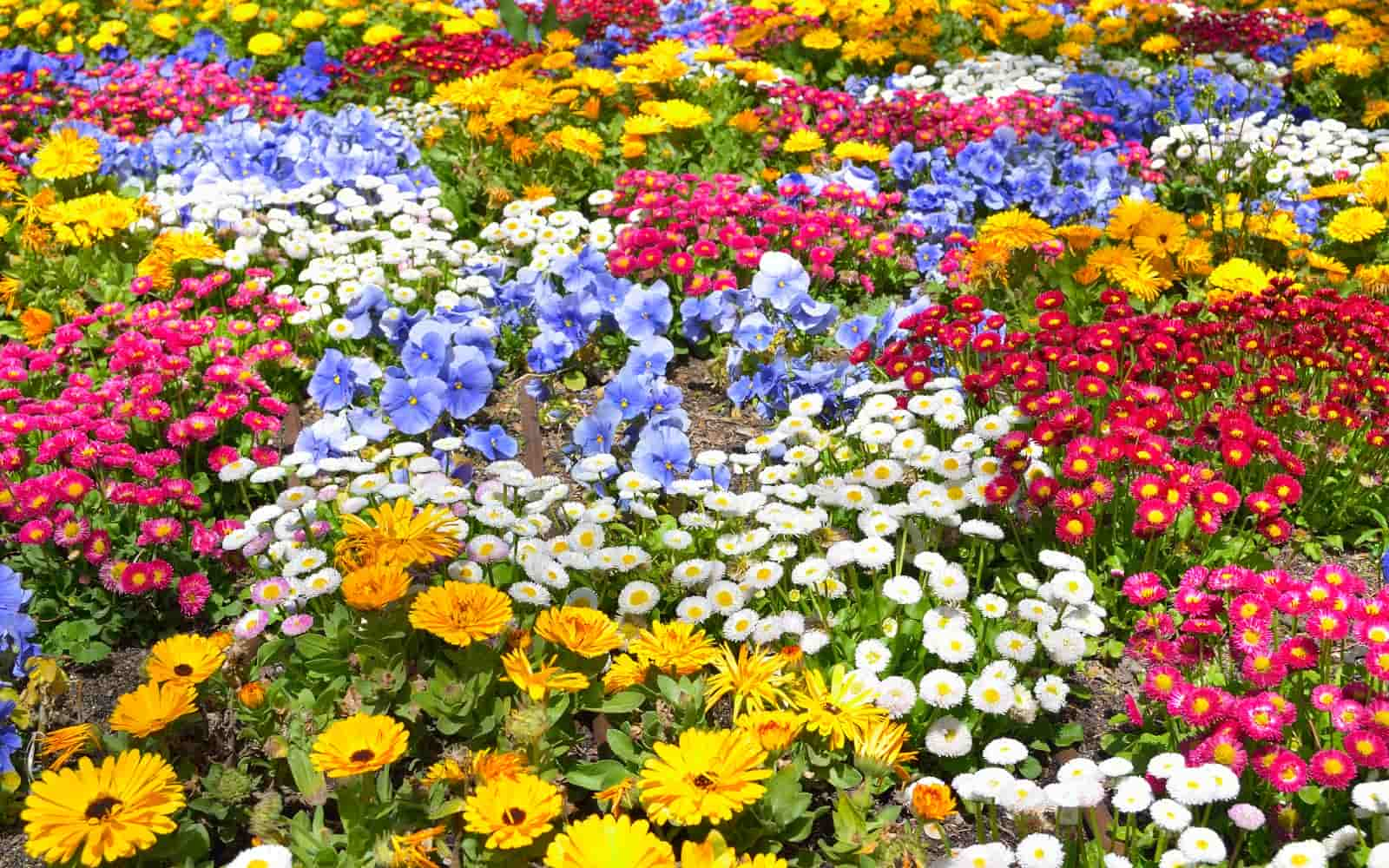
White gardens reflect all the light that strikes them. It’s the easiest color to work within the garden as it can be used with any other color.
You can combine it with grey and green foliage. White flowers are fresh and cool while being clean and elegant. Texture and shape are critical in white gardens as there is less variance in flower color to capture interest.
White is an excellent choice to use around shady areas as the white garden has high reflective value.
Types of plants to use when designing a garden
Let’s consider the different plant types that you can use in your garden.
Annuals
The annual plants are used for season-long color. Unlike perennials, annual plants keep blooming from spring until frost. This gives them a long flowering period and has lots to offer in a garden.
There are so many different types of annuals to choose from that provide unique and colorful foliage. Annuals allow you to try something different each year.
It keeps your garden fresh and lively. Some annuals, like petunias, need to have old flowers removed to rebloom. But other annuals repeat bloom without pruning making them easy-care additions for borders and pots.
You can use annuals in two ways, bedding plants or drop in among trees, shrubs, and herbs. You can add annuals among perennials that add depth and interest to the garden.
The nonstop flowers and perpetually lush foliage draw attention from slow-growing flowers or late bloomers.
Here is a list of ten easy to grow annuals.
| Begonia | Marigold |
| Browallia | Million bells |
| Coleus | Torenia |
| Fuchsia | Verbena |
| Inpatients | Zinnia |
Vines and climbers
Vines are especially useful for small gardens or where space is limited. Climbers grow upon another plant or support instead of out, and they are great to cover walls or fences.
There are different types of vines that you can plant as some flower, while others grow edible fruits or vegetables. For example, morning glory is an annual vine that provides a quick and easy color.
Perennial vines such as clematis and ivy expand their coverage year after another. Some perennial vines can be evergreen, like star jasmine, or deciduous like trumpet vine and wisteria.
Depending on the type of vine, each climb differently, such as twining, tendrils, or clinging roots. Try to match how a vine grows to what you want it to grow on.
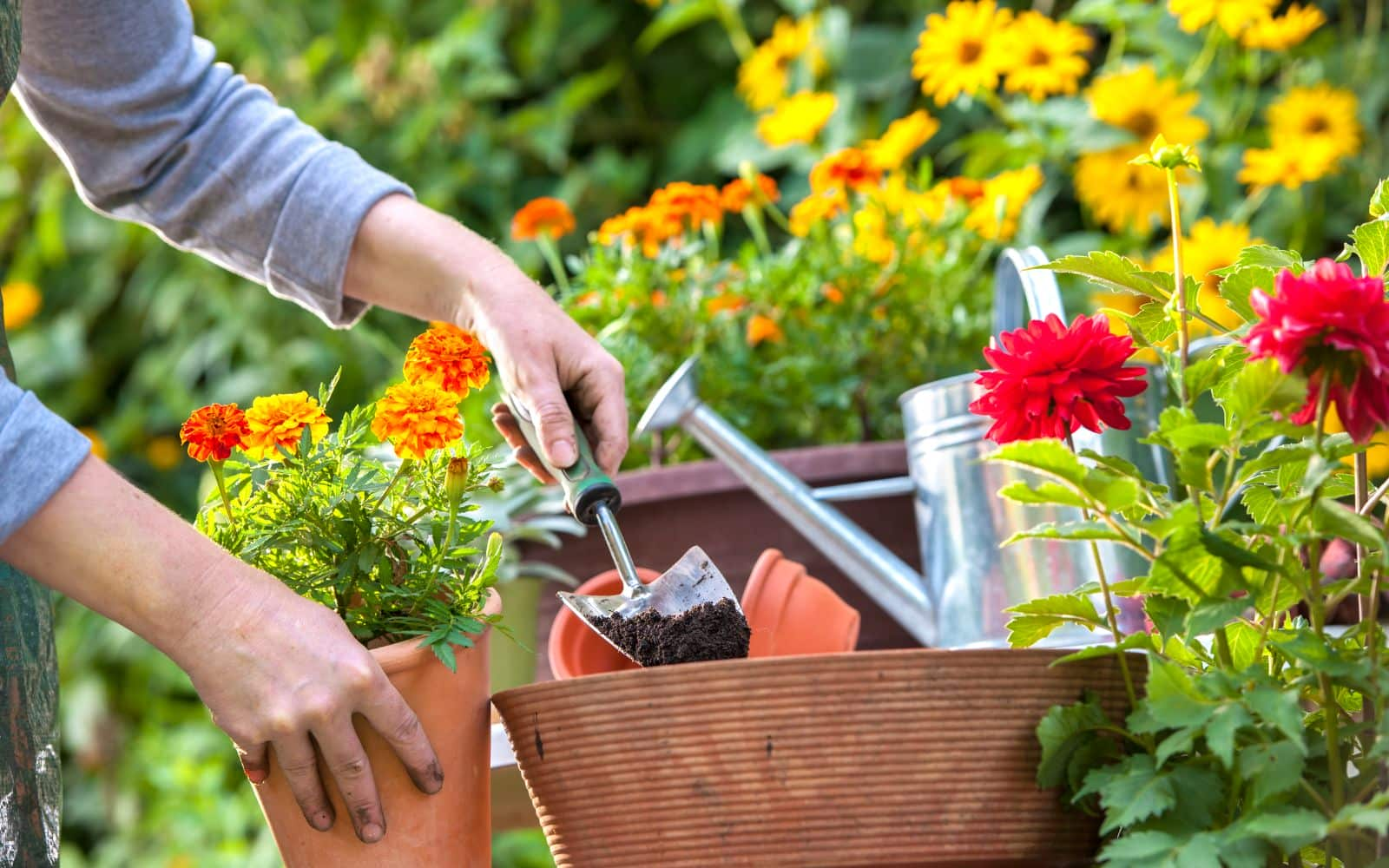
How to care for newly purchased plants
It’s always fun and exciting to bring a newly purchased plant home.
But do you know how to care for it properly, so you have a better chance of keeping it alive and growing it to its fullest?
Here are some tips for caring for newly purchased plants.
- If you have ordered new plants through online retailers, you may have received in sturdy packaging. You should open boxes immediately upon receipt and moisten any dried-out plants.
- Always harden off the plants before planting. You can do it by keeping plants in a shaded area away from direct sunlight during the day and moving it inside at a stable temperature at night. Over one to two weeks, gradually increase their exposure to the sun and leave them outside if there is no frost risk.
- Any bare-root plants should be planted in your garden as soon as possible. You may leave it in a cool place by leaving the roots moist if you plan to grow it in a day or two.
- You should move annuals or perennials plants into larger pots that are outgrowing their containers and become root-bound. Check out the overgrown roots, and if you find any root that is spiraled around the pot or tightly packed, you can break them up and spread it out in a bigger container.
- Pinch off blooms to save the plant’s energy until it’s settled in its permanent home.
Key Takeaways
In this chapter, you learned the basic design principles and various ways you can get started with your own design that you like.
What Next?
How to Get Started with a Speciality Garden
Next, we’re going to show you:
- What are specialty gardens, and why should you consider one?
- How to get started with Container Gardening
- Easy ways to get started with Hydroponics
- What are raised garden beds? And why should you consider this?
- How to get started with Herbal Gardening and herbs that you can quickly grow in any garden

